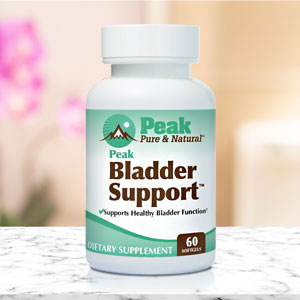Get Easy Health Digest™ in your inbox and don’t miss a thing when you subscribe today. Plus, get the free bonus report, Mother Nature’s Tips, Tricks and Remedies for Cholesterol, Blood Pressure & Blood Sugar as my way of saying welcome to the community!
Overactive bladder: Causes, risk factors and fixes

Overactive bladder (OAB) is just what it sounds like: A condition that causes the sudden and frequent urge to urinate.
OAB isn’t uncommon. It affects as many as 16 percent of adult men and 33 percent of adult women.
Overactive bladder can be neurogenic, caused by neurological problems such as stroke or spinal cord injuries. Neurogenic OAB can also be a result of Parkinson’s disease, multiple sclerosis, spina bifida or Alzheimer’s disease.
But in many cases, an overactive bladder has no apparent neurological cause and is known as non-neurogenic.
One of the inconvenient things about OAB is that it leaves you with little or no control over your bladder, often resulting in urinary incontinence.
The risk for OAB increases with age, but you shouldn’t consider it to be just a normal, inevitable consequence of aging. If you’re experiencing problems, consider these common causes…
Common causes of non-neurogenic overactive bladder
Recurrent urinary tract infections. Some studies have linked repeated UTIs with bladder hyperactivity, especially in women.
Pelvic organ prolapse. Pelvic organ prolapse is more common in women than in men. It refers to the prolapse, or drooping, of any of the pelvic floor organs, including the bladder, uterus, vagina, small bowel or rectum. A severe case is associated with an increased risk of overactive bladder.
Enlarged prostate. An enlarged prostate gland can place direct pressure on the bladder when it tries to empty. Partial urination is often the result, but eventually, the irritation on the bladder can lead to an overactive bladder.
Hip surgery or hip problems. Either of these hip complications can alter the position of (and place undue stress on) the organs of the lower urinary tract, including the bladder.
Low estrogen levels. Estrogen levels tend to drop after menopause. This can affect the function of the muscles that control urination: the detrusor muscle in the wall of the bladder, and the urethral sphincter muscles, which control the exit of urine from the body.
Kidney stones. These solid mineral deposits can form in the kidney or the bladder. They place pressure on the bladder, creating a stronger and more frequent urge to urinate.
Urinary catheter use. A urinary catheter is a hollow, partially flexible tube that collects urine from the bladder and leads to a drainage bag. A catheter is used after surgery or injury, or at other times when a patient is unable to control their bladder.
Prolonged use of a catheter can irritate the bladder and/or prostate gland, and the irritation can persist even after the catheter has been removed.
Lifestyle factors that increase risk of OAB
Some common lifestyle factors increase the likelihood of having an overactive bladder. These factors promote bladder infection, stress on the bladder, and excessive urination, all of which are “triggers” for the condition.
Obesity. Being obese seems to increase the risk of OAB in women more than men. It increases urinary frequency, especially at night.
Caffeine. Caffeine is a diuretic (it promotes urination as a way to remove water from the body).
And it’s not just the caffeine in coffee that can do this. Tea, chocolate, colas, and energy drinks, when consumed in excess, can act as diuretics.
Overhydration. Drinking too much fluid can be just as bad as not getting enough. So, don’t go overboard, and remember that everything you drink counts as far as your bladder is concerned, not just water.
According to the U.S. National Academies of Sciences, Engineering, and Medicine, the requirements for daily water intake are 11.5 cups (2.7 liters) for women and 15.5 cups (3.7 liters) for men.
Alcohol. Not only is alcohol a diuretic, but it can increase the acidity of urine, which irritates the bladder.
Smoking. Smoking promotes overactive bladder because it increases the risk of hardening of the arteries (atherosclerosis), which affects the bladder as well as the cardiovascular system.
Medications. Diuretic medications are used to treat high blood pressure, but they cause increased urination and are linked to an increased risk of OAB in adults 75 and over.
Help for your bladder
Your bladder is a muscle, and like any muscle, it can be trained.
Kegel exercises involve squeezing the muscles you’d use to stop urinating. No time to do them? Kegels can be done while sitting or even driving as long as you keep your focus on the road.
Some supplements may also help. Research has shown pumpkin seed extract can have a positive effect on these annoying symptoms. One such study of 45 men and women with overactive bladder taking the extract daily for 12 weeks showed a 1.7 point reduction on the bladder scoring system, with decreased daytime and nighttime frequency along with decreased urgency.
It’s also important to actively maintain the health of your bladder. Here are 18 do’s and don’ts for keeping your bladder strong and healthy that can get you headed in the right direction.
Editor’s note: Did you know that when you take your body from acid to alkaline you can boost your energy, lose weight, soothe digestion, avoid illness and achieve wellness? Click here to discover The Alkaline Secret to Ultimate Vitality and revive your life today!
Sources:
Causes and Risk Factors of Overactive Bladder — very well health
Nature’s Answer to Overactive Bladder — Easy Health Options
Pumpkin Seed Oil Extracted From Cucurbita maxima Improves Urinary Disorder in Human Overactive Bladder — Journal of Traditional and Complementary Medicine













